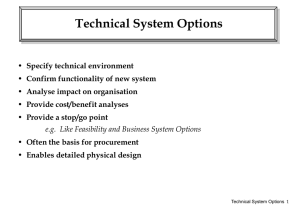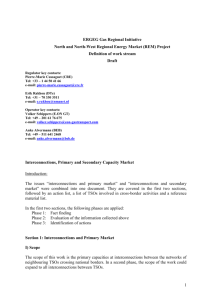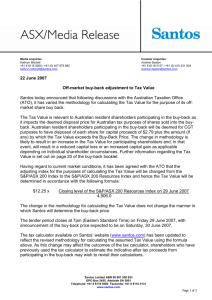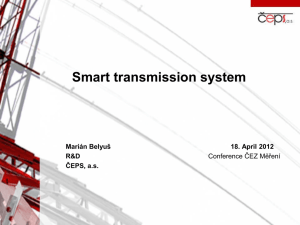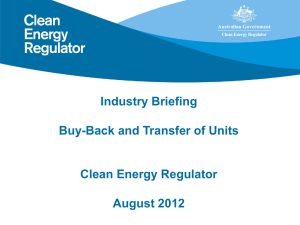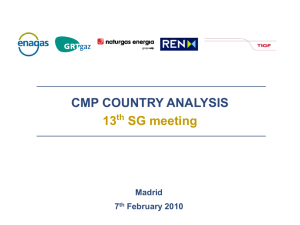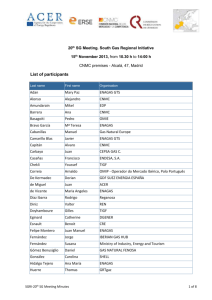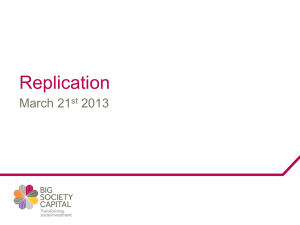Draft CMP Roadmap
advertisement
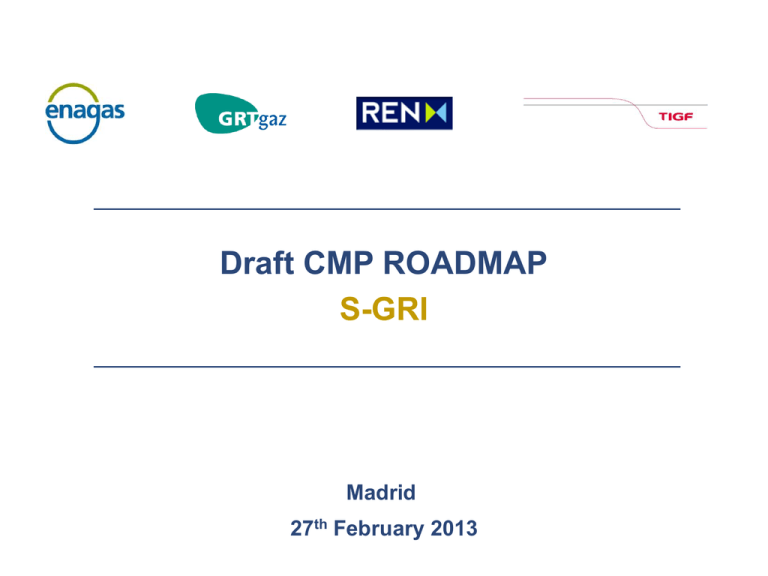
Draft CMP ROADMAP S-GRI Madrid 27th February 2013 CMP Context • o o • Commission decision of 24 August 2012 on amending Annex I to Regulation (EC) No 715/2009 “Therefore it is necessary to amend the guidelines on the application of congestionmanagement procedures in the event of contractual congestion” “The congestion-management procedures should apply in the event of contractual congestion and are aimed at resolving those events by bringing unused capacity back to the market to be reallocated in the course of the regular allocation processes. Where an interconnection point is frequently subject to the occurrence of physical congestion, congestion management procedures may often be of no avail. In those cases a solution should be examined from a network planning and investment point of view.” Key milestones: o UIOLI LT, Capacity surrender operational at concerned IPs, Oversubscription and Buy-back operational at concerned IPs : 1st October 2013 o UIOLI FIRM ST operational: 1st July 2016 2 CMP implementation • TSOs are currently working on a common proposal for the implementation of UIOLI LT, Surrender and Oversubscription and Buy-back mechanisms • Work on UIOLI DA will be launched by 2014 • The different mechanisms need a detailed analysis by TSOs and further coordinated definitions from NRAs • Oversubscription and buy-back mechanisms request a particular evaluation of the congestion situation due to the risks/rewards associated for TSOs • The following Draft CMP Roadmap is a proposal and must not be seen as a formal engagement from TSOs until further precisions are given to the different mechanisms 3 UIOLI LT (under discussion between Enagás, REN and TIGF) • UIOLI LT is already under application in France since 2007 and since 2003 in Spain. • TSOs are working in a proposal to adapt the existing rules under application to the new rules and to CAM auctions • For the interim period (before the start of CAM auctions) continue with current arrangements • Once CAM auctions are in place: application of UIOLI LT mechanism if demand exceeded offer at the Yearly capacity auctions by IP 4 UIOLI LT (under discussion between Enagás, REN and TIGF) • Evaluation of the underutilisation of capacity and application of UIOLI LT to be done every year after the Yearly Capacity auctions • Two semesters will be analysed independently (1 April – 30 September and 1 October – 31 March) • Only yearly capacity products will be analysed and only capacity related to yearly capacity products will be released • Withdrawal if capacity use is <80% on both semesters analysed • Withdrawn capacity to be offered through Quarterly capacity auctions • Capacity to be withdrawn up to demand exceeding offer at P0 (Reserve price) • If the clearing price of the reallocated capacity is lower than the clearing price of the capacity initially allocated, the initial holder of the capacity will retain its payment obligations for the difference of clearing prices 5 Capacity Surrender (under discussion between GRTgaz and TIGF) • TSO shall accept any surrender of firm capacity (except products with a daily duration, DA et WD) • Surrendered capacity shall be considered to be reallocated only after all the available capacity has been allocated • Product subdivision: CAM calendar implies to surrender capacity only via a shorter term product Initial Product Shipper surrender TSO allocation Quarterly Product One or several months Month Yearly Product (Y+1) One or several quarters/months Quarter/Month 6 Capacity Surrender (under discussion between GRTgaz and TIGF) • In case, several product are surrendered, a first-come-first-served (time stamp) mechanism shall be used to decide on the order of allocation • Each surrendered capacity shall be definitively surrendered until the rolling monthly allocation (unsold capacity is given back to the shipper after the rolling monthly auction) • A fee is to be introduced to reflect the cost of service and to avoid a loss of revenue for the TSO 7 Oversubscription and buy-back (under discussion between GRTgaz and TIGF) • Statistic studies shall be used to define the amount of additional capacities (if no physical congestion is observed at the concerned IP) • Taking into account the limitation of a statistic study, additional capacities should be limited to annual Y+1, Quarter, Month and Day-ahead product • Buy-back scheme: when and if necessary, TSO shall o 1st : Verify whether alternative technical and commercial measures can maintain system integrity in a more cost-efficient manner o 2nd : Apply a market-based buy-back procedure • This mechanism necessitates a strong coordination amongst adjacent TSOs and NRAs to propose additional capacities and to define a rule on the buy-back procedure o An oversubscribed capacity at one side of the IP has to “find” the equivalent on the other side to be bundled 8 Oversubscription and buy-back (under discussion between GRTgaz and TIGF) • Several market-based buy-back procedure could be used o Option mechanism o Market intervention • The adequate mechanism has to further detailed, discussed at EU level and with the market o In particular: no interest to develop a specific IT tool at one TSO level • All potentially envisaged mechanisms will imply to define a default rule o To guarantee the effectiveness of the oversubscription o To mitigate the risks for the TSO • When buy-back mechanism is activated, shippers don’t have anymore the right to revise upwards their (re)nomination 9 Oversubscription and buy-back (under discussion between GRTgaz and TIGF) • This implementation will incur costs and risks for TSOs which have to be covered and incentivised • Proposition of a gradual implementation: o October 2013: implementation at some IPs using only the default rule o 2014-2015: implementation using a market based mechanism in coordination with other TSOs 10 Thank you for your attention!
